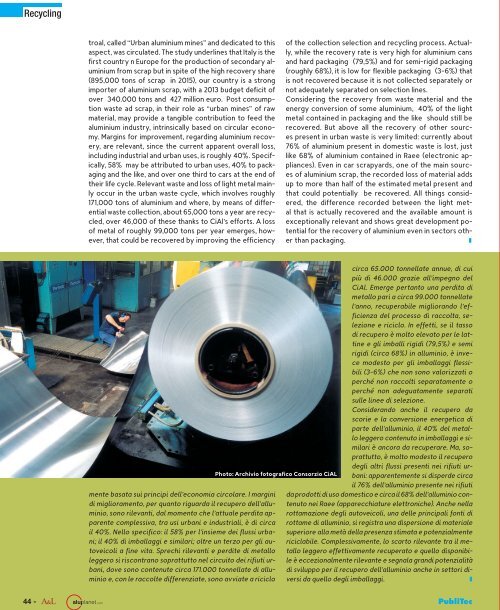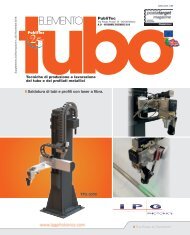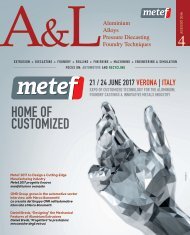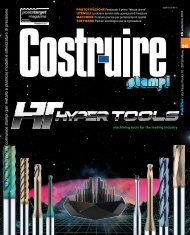Sfogliabile_AeL_n3_GIUGNO_2016
- No tags were found...
Create successful ePaper yourself
Turn your PDF publications into a flip-book with our unique Google optimized e-Paper software.
Recycling<br />
troal, called “Urban aluminium mines” and dedicated to this<br />
aspect, was circulated. The study underlines that Italy is the<br />
firstcountrynEuropefortheproductionofsecondaryaluminium<br />
from scrap but in spite of the high recovery share<br />
(895,000 tons of scrap in 2015), our country is a strong<br />
importer of aluminium scrap, with a 2013 budget deficit of<br />
over 340.000 tons and 427 million euro. Post consumptionwasteadscrap,intheirroleas“urbanmines”ofraw<br />
material, may provide a tangible contribution to feed the<br />
aluminium industry, intrinsically based on circular economy.<br />
Margins for improvement, regarding aluminium recovery,<br />
are relevant, since the current apparent overall loss,<br />
including industrial and urban uses, is roughly 40%. Specifically,<br />
58% may be attributed to urban uses, 40% to packaging<br />
and the like, and over one third to cars at the end of<br />
their life cycle. Relevant waste and loss of light metal mainly<br />
occur in the urban waste cycle, which involves roughly<br />
171,000 tons of aluminium and where, by means of differential<br />
waste collection, about 65,000 tons a year are recycled,<br />
over 46,000 of these thanks to CiAl’s efforts. A loss<br />
ofmetalofroughly99,000tonsperyearemerges,however,<br />
that could be recovered by improving the efficiency<br />
ofthecollectionselectionandrecyclingprocess.Actually,<br />
while the recovery rate is very high for aluminium cans<br />
and hard packaging (79,5%) and for semi-rigid packaging<br />
(roughly68%),itislowforflexiblepackaging (3-6%)that<br />
is not recovered because it is not collected separately or<br />
not adequately separated on selection lines.<br />
Considering the recovery from waste material and the<br />
energy conversion of some aluminium, 40% of the light<br />
metal contained in packaging and the like should still be<br />
recovered. But above all the recovery of other sources<br />
present in urban waste is very limited: currently about<br />
76% of aluminium present in domestic waste is lost, just<br />
like 68% of aluminium contained in Raee (electronic appliances).<br />
Even in car scrapyards, one of the main sources<br />
of aluminium scrap, the recorded loss of material adds<br />
up to more than half of the estimated metal present and<br />
that could potentially be recovered. All things considered,<br />
the difference recorded between the light metal<br />
that is actually recovered and the available amount is<br />
exceptionally relevant and shows great development potential<br />
for the recovery of aluminium even in sectors other<br />
than packaging.<br />
❚<br />
Photo: Archivio fotografico Consorzio CiAL<br />
mente basata sui principi dell’economia circolare. I margini<br />
di miglioramento, per quanto riguarda il recupero dell’alluminio,<br />
sono rilevanti, dal momento che l’attuale perdita apparente<br />
complessiva, tra usi urbani e industriali, è di circa<br />
il 40%. Nello specifico: il 58% per l’insieme dei flussi urbani;<br />
il 40% di imballaggi e similari; oltre un terzo per gli autoveicoli<br />
a fine vita. Sprechi rilevanti e perdite di metallo<br />
leggero si riscontrano soprattutto nel circuito dei rifiuti urbani,<br />
dove sono contenute circa 171.000 tonnellate di alluminio<br />
e, con le raccolte differenziate, sono avviate a riciclo<br />
circa 65.000 tonnellate annue, di cui<br />
piùdi46.000grazieall’impegnodel<br />
CiAl. Emerge pertanto una perdita di<br />
metallo pari a circa 99.000 tonnellate<br />
l’anno, recuperabile migliorando l’efficienza<br />
del processo di raccolta, selezione<br />
e riciclo. In effetti, se il tasso<br />
di recupero è molto elevato per le lattineegliimballirigidi(79,5%)esemi<br />
rigidi (circa 68%) in alluminio, è invece<br />
modesto per gli imballaggi flessibili(3-6%)chenonsonovalorizzatio<br />
perché non raccolti separatamente o<br />
perché non adeguatamente separati<br />
sulle linee di selezione.<br />
Considerando anche il recupero da<br />
scorie e la conversione energetica di<br />
parte dell’alluminio, il 40% del metallo<br />
leggero contenuto in imballaggi e similari<br />
è ancora da recuperare. Ma, soprattutto,<br />
è molto modesto il recupero<br />
deglialtriflussipresentineirifiutiurbani:<br />
apparentemente si disperde circa<br />
il 76% dell’alluminio presente nei rifiuti<br />
da prodotti di uso domestico e circa il 68% dell’alluminio contenuto<br />
nei Raee (apparecchiature elettroniche). Anche nella<br />
rottamazione degli autoveicoli, una delle principali fonti di<br />
rottame di alluminio, si registra una dispersione di materiale<br />
superiore alla metà della presenza stimata e potenzialmente<br />
riciclabile. Complessivamente, lo scarto rilevante tra il metallo<br />
leggero effettivamente recuperato e quello disponibile<br />
è eccezionalmente rilevante e segnala grandi potenzialità<br />
di sviluppo per il recupero dell’alluminio anche in settori diversi<br />
da quello degli imballaggi.<br />
❚<br />
44 -<br />
.com<br />
PubliTec





